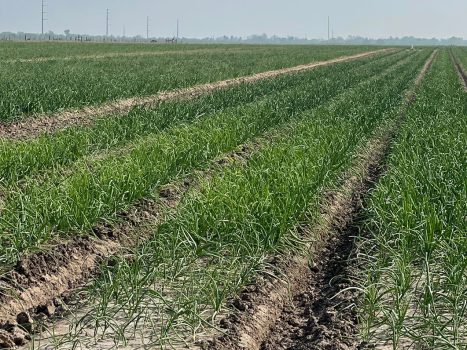Are we there yet? We remember, vividly in fact, a year ago almost exactly wondering if 2020 would ever end and at the same time wondering if 2021 would be an improvement. Year 2020 was, if you recall, a hot mess.
Today we’re thinking maybe 2020 might have been the warm-up act, because while 2021 has had more high points than the previous year, in some ways it has eclipsed the Year of the Covid-19 Pandemic/Nationwide Lockdown/Crop Distribution Uncertainty/Reopening (or not) of Foodservice/Etc. Etc. Etc.
Think of it this way: 2020 was a dumpster fire, and in some ways 2021 was a prairie fire – not universally, but definitely from a circle-the-wagons point of view.
Here’s a look back at the good (for which we give thanks) the bad (hoo boy) and the ugly (yech!). We give you 2021 in Review.
January saw the outgoing Trump Administration’s USDA launch its fifth round of the Farmers to Families Food Box Program. U.S. Secretary of Agriculture Sonny Perdue announced on Monday, Jan. 4, that the USDA would purchase an additional $1.5 billion worth of food for its Farmers to Families Food Box Program, with the program having distributed more than 132 million boxes in support of both American farmers and families affected by the COVID-19 pandemic.
We also found out in January that the South Texas Onion Committee referendum that had been held the previous fall failed to sustain Marketing Order 959. After considerable back-and-forth, the USDA hosted a public comment period on its website during September and October and then extended that comment period another 30 days from November into December. The majority of respondents during the first comment period asked to retain the marketing order; five new comments were received during the second, four of which favored termination. At this writing the final outcome remains uncertain.
The onion market had responded predictably to the shutdown and slow restart of foodservice and was described variously as “slow” and “doggy.”
February brought a whole new dimension to the picture: weather. Texas was hit by freeze temps and ice storms on Feb. 12, and tens of thousands of residents and businesses were without power for days. More than 200 deaths were reported statewide, and in addition to the disruptions caused by the blackout, Texas crops were either lost or diminished. Onions ended up coming in short. On the good news side in February, foodservice saw an uptick for the first time in an extended period, which was well-received by all sides of the supply-and-demand sphere.
March brought news of the merger PMA and United Fresh to form a “new global trade association” with an official launch Jan. 1, 2022. The storage onion market continued to make gains, which bolstered optimism. Mexican onions were coming in as well. The nation’s summer onions were gearing up for the marketplace. On the transportation side, trucker shortages were leading conversations – the shape of things to come.
April had the Farmers to Families Food Box Program riding off into the sunset, to be replaced in late May or early June by the Biden Administration’s The Emergency Food Assistance Program. The new program significantly reduced the quantity of onions being purchased, but on the upside, the rebound of foodservice continued. California, Vidalia and the Texas Rio Grande Valley all started shipping their new crops in April. Storage onions also saw steady movement.
May markets were steady, with the Texas Rio Grande Valley cleaning up and New Mexico coming in. Walla Walla was gearing up for its new shipping season as well.
June saw most of our contributors report steady markets again, but the transportation situation was worsening. Certain supplies – packaging materials, pallets, etc. – were becoming harder to obtain. Labor was also an increasingly significant problem for the industry.
July had ongoing reports of worker shortages across the industry – from field works to truck drivers to warehouse to retail to foodservice. Many of our contributors said the incentive to return to work after the lockdown had been tempered by government checks, and an oft-repeated comment was, “People are being paid more to stay home than to return to work.” The Northwest was getting ready for a new season’s start, and parts of Colorado were getting ready to come on as well. Demand was mostly steady, but some shippers were citing too-low markets. A heat wave was blanketing the Western States, affecting crops and cutting some seasons short.
August had Walla Walla wrapping up with less volume due to the heart and Idaho-E. Oregon and Washington kicking off their new crops. But those areas’ yields and volumes were affected by the heat as well. We also reported on California’s worsening drought and its baffling no-diversion policy that curtails “nearly all agricultural water diversions from the Sacramento-San Joaquin Delta watershed, which stretches about 500 miles from near the Oregon border to near the Tehachapi Mountains” while maintain flows for spawning salmon.
September saw good demand for NW onions, and demand and markets were strong, particularly for the short volumes of larger sizes. The prevailing mood was positive, although transportation and labor were still thorns in the side.
PMA canceled its in-person convention in New Orleans due to ongoing COVID restrictions and the disruption to services caused by Hurricane Ida.
In October the National Restaurant Association published an article outlining the ramifications of shortages in that industry – not only in labor but also in supplies. Its findings were that 95 percent of operators surveyed said their businesses had seen supply delays or shortages of key food or beverage items in 2021. That was across the spectrum – fast food, sit-down, take-out, fine dining – and the effects were forcing the restaurants to change their menus. “The segment most like to be impacted was table-service restaurants, and the story said that 88 percent of fine dining and 81 percent of casual dining operators said their menus had changed as a result of food supply delays or shortages.” A harbinger. Demand was steady, and pricing ahead of the Thanksgiving pull was called “stable.” Shipping rates were, at least temporarily, lower. A recall was issued for Mexican onions distributed by some U.S. companies.
November saw good demand, strong markets, and excellent quality, but the situation with trucks and drivers was, in the words of several contributors, “The worst I’ve ever seen.” Trucks were expensive if they were found, and most were being taken by major retailers were snagging them for holiday goods deliveries. The phrase “supply chain” was being used more and more. We were seeing more and more examples of robotics being used in the industry – weeders, forklifts, driverless trucks.
December has been up in general, with demand and markets reported as steady-to-strong. Some shippers in the Northwest have been pacing their supplies to meet obligations, and some are expecting to clean up earlier in 2022. Christmas season had been busy; transportation remained very tight and very expensive. A Zoom forum Onion Business hosted during the Onion Association Convention in San Juan, Puerto Rico, reinforced the sentiments that critical shortages of labor, lack, and price of transportation, and increasing costs of production are surging ahead of profits.
Still, we’re seeing and sensing optimism, which is a hallmark of the industry. And we’re looking ahead at 2022 with the hopes of resolution in some of the issues. Year 2020 was fraught with challenges and uncertainty, year 2021 brought some positive moments but also its own issues of higher production costs and the constant threat of not having enough warm bodies to get the job done or product delivered. What might 2022 bring?
You tell us what you think. We’d love to hear… because we’re out of educated guesses.
Happy New Year, everyone.



